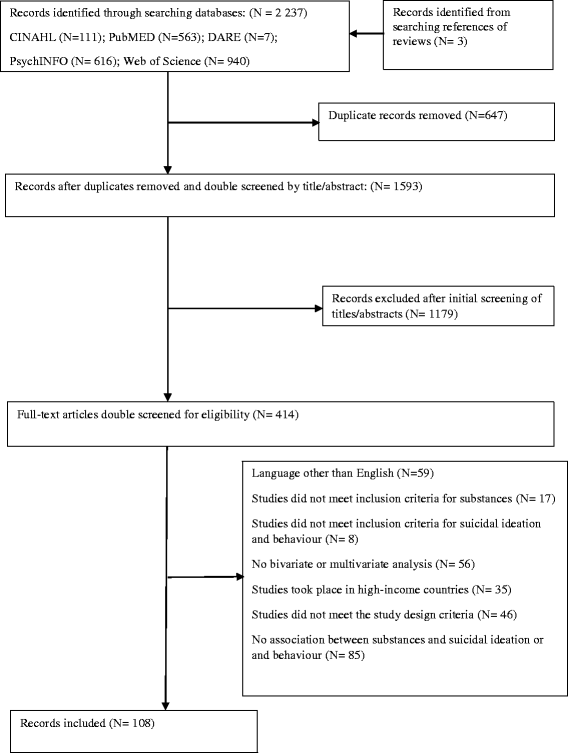Substance use and suicidal ideation and behaviour in low- and middle-income countries: a systematic review
- PMID: 29699529
- PMCID: PMC5921303
- DOI: 10.1186/s12889-018-5425-6
Substance use and suicidal ideation and behaviour in low- and middle-income countries: a systematic review
Abstract
Background: Understanding relationships between substance use and suicidal ideation and behaviour (SIB) has important public health implications for suicide prevention in low- and middle-income countries (LMICs), where 75% of suicides occur. This systematic review explored the associations between substance use and SIB in LMICs.
Methods: We searched five databases using a combination of keywords for substance use, SIB and LMICs to identify English-written quantitative studies published between January 2006 and February 2016. Data were extracted to provide an overview of what is known about the topic, highlight gaps in the literature, and explore the implications of current knowledge for suicide prevention. Studies included in the review were assessed for methodological quality using the Scottish Intercollegiate Guidelines Network checklist.
Results: Analysis of included studies (N = 108) demonstrated a consistent positive association between substance use and SIB across all substances (i.e. alcohol, tobacco, cannabis, illicit drugs, non-medical use of prescription drugs), all substance use dimensions (i.e. intoxication, use, and pathological use) and all SIB dimensions (i.e. suicidal ideation, non-fatal suicidal behaviour, and suicide). Most of the available research evidence comes from upper-middle-income countries, only 22% comes from lower-middle-income and low-income countries. Most studies focused on alcohol and tobacco, while neglecting substances such as cannabis, opioids, sedatives, stimulants, misuse of prescription medication, inhalants, and hallucinogens. Most of the studies employed a cross-sectional design, were conducted within a risk-factor paradigm, and provided little information about the potential interaction between variables.
Conclusions: Public health suicide prevention policy and research in LMICs should take account of the fact that: substance use is a potentially modifiable risk factor; assessment and management of substance use is integral to the care of at-risk patients; reducing consumption and hazardous use of substances in LMICs is important for suicide prevention; and research needs to be expanded to include more theory driven research that focuses on all substance use dimensions and SIB dimensions, while employing more sophisticated statistical methods.
Keywords: Low- and middle-income countries; Substance use; Suicidal ideation and behaviour; Suicide prevention; Systematic review.
Conflict of interest statement
Ethics approval and consent to participate
Not applicable.
Competing interests
The authors declare that they have no competing interests.
Publisher’s Note
Springer Nature remains neutral with regard to jurisdictional claims in published maps and institutional affiliations.
Figures
References
-
- World Health Organisation. Preventing suicide: a global imperative. WHO, 2014. http://apps.who.int/iris/bitstream/10665/131056/1/9789241564779_eng.pdf?.... Accessed 16 Sept 2015.
-
- World Health Organisation. Mental health action plan 2013–2020. WHO, 2013. http://apps.who.int/iris/bitstream/10665/89966/1/9789241506021_eng.pdf. Accessed 23 July 2015.
-
- Platt S, Bille-Brahe U, Kerkhof A, Schmidtke A, Bjerke T, Crepet P, et al. Parasiticide in Europe: the WHO/EURO multicentre study on parasuicide. I. Introduction and preliminary analysis for 1989. Acta Psychiatr Scand. 1992;85:97–104. - PubMed
-
- Rehm J, Mathers C, Popova S, Thavorncharoensap M, Teerawattananon Y, Patra J. Global burden of disease and injury and economic cost attributable to alcohol use and alcohol-use disorders. Lancet. 2009;373:2223–2233. - PubMed
-
- WHO . Global status report on alcohol and health 2014. Geneva: World Health Organization; 2014.
Publication types
MeSH terms
Grants and funding
LinkOut - more resources
Full Text Sources
Other Literature Sources
Medical


